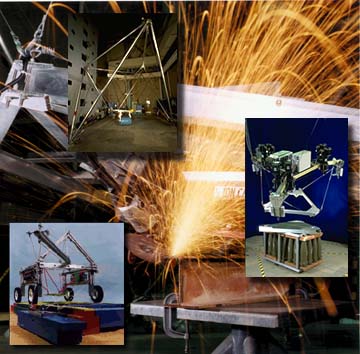Robocrane on:
[Wikipedia]
[Google]
[Amazon]
 The Robocrane is a kind of manipulator resembling a
The Robocrane is a kind of manipulator resembling a
Accessed Aug 2, 2009. A version of the RoboCrane has been commercially developed for the
Manipulation and Mobility Systems GroupCitations: The NIST ROBOCRANE - Albus, Bostelman, Dagalakis
a page from
MEL Gallery Movies RoboCrane
-
 The Robocrane is a kind of manipulator resembling a
The Robocrane is a kind of manipulator resembling a Stewart platform
A Stewart platform is a type of parallel manipulator that has six prismatic actuators, commonly hydraulic jacks or electric linear actuators, attached in pairs to three positions on the platform's baseplate, crossing over to three mounting po ...
but using an octahedral assembly of cables instead of struts. Like the Stewart platform, the Robocrane has six degrees of freedom
Degrees of freedom (often abbreviated df or DOF) refers to the number of independent variables or parameters of a thermodynamic system. In various scientific fields, the word "freedom" is used to describe the limits to which physical movement or ...
(x, y, z, pitch, roll, & yaw).
It was developed by Dr. James S. Albus
James Sacra Albus (May 4, 1935 – April 17, 2011) was an American engineer, Senior NIST Fellow and founder and former chief of the Intelligent Systems Division of the Manufacturing Engineering Laboratory at the National Institute of Standards an ...
of the US National Institute of Standards and Technology
The National Institute of Standards and Technology (NIST) is an agency of the United States Department of Commerce whose mission is to promote American innovation and industrial competitiveness. NIST's activities are organized into physical sci ...
(NIST), using the Real-Time Control System which is a hierarchical control system A hierarchical control system (HCS) is a form of control system in which a set of devices and governing software is arranged in a hierarchical tree. When the links in the tree are implemented by a computer network, then that hierarchical control sy ...
. Given its unusual ability to "fly" tools around a work site, it has many possible applications, including stone carving, ship building, bridge construction, inspection, pipe or beam fitting and welding.
Albus invented and developed a new generation of robot cranes based on six cables and six winches configured as a Stewart platform. The NIST RoboCraneTM has the capacity to lift and precisely manipulate heavy loads over large volumes with fine control in all six degrees of freedom. Laboratory RoboCranes have demonstrated the ability to manipulate tools such as saws, grinders, and welding torches, and to lift and precisely position heavy objects such as steel beams and cast iron pipe. In 1992, the RoboCrane was selected by Construction Equipment magazine as one of the 100 most significant new products of the year for construction and related industries. It was also selected by Popular Science
''Popular Science'' (also known as ''PopSci'') is an American digital magazine carrying popular science content, which refers to articles for the general reader on science and technology subjects. ''Popular Science'' has won over 58 awards, incl ...
magazine for the "Best of What's New" award as one of the 100 top products, technologies, and scientific achievements of 1992.CURRICULUM VITAE FOR JAMES S. ALBUSAccessed Aug 2, 2009. A version of the RoboCrane has been commercially developed for the
United States Air Force
The United States Air Force (USAF) is the air service branch of the United States Armed Forces, and is one of the eight uniformed services of the United States. Originally created on 1 August 1907, as a part of the United States Army Signal ...
to enable rapid paint stripping, inspection, and repainting of very large military aircraft such as the C-5 Galaxy. RoboCrane is expected to save the United States Air Force $8 million annually at each of its maintenance facilities. This project was recognized in 2008 by a National Laboratories Award for technology transfer. Potential future applications of the RoboCrane include ship building, construction of high rise buildings, highways, bridges, tunnels, and port facilities; cargo handling, ship-to-ship cargo transfer on the high seas, radioactive and toxic waste clean-up; and underwater applications such as salvage, drilling, cable maintenance, and undersea waste site management.
References
{{reflistExternal links
Manipulation and Mobility Systems Group
a page from
Carnegie Mellon University
Carnegie Mellon University (CMU) is a private research university in Pittsburgh, Pennsylvania. One of its predecessors was established in 1900 by Andrew Carnegie as the Carnegie Technical Schools; it became the Carnegie Institute of Technology ...
MEL Gallery Movies RoboCrane
-